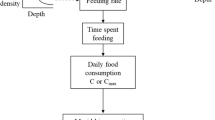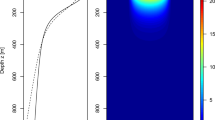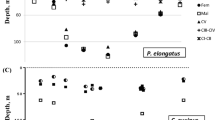Abstract
Predator and prey react to each other, adjusting their behavior to maximize their fitness and optimizing their food intake while keeping their predation risk as low as possible. In a pelagic environment, prey reduce their predation mortality by adopting a diel vertical migration (DVM) strategy, avoiding their predator during their peak performance by finding refuge in deep layers during daylight hours and feeding at the surface during the night. Due to the duality of the interaction between prey and predator, we used a game theory approach to investigate whether DVM can be a suitable strategy for the predator as well as the prey. We formulated three scenarios in plankton ecology in order to address this question. A novel finding is that mixed strategies emerge as optimal over a range of the parameter space, where part of the predator or prey population adopts a DVM while the rest adopt one or other “sit and wait” strategies.




Similar content being viewed by others
References
Aksnes D, Giske J (1993) A theoretical model of aquatic visual feeding. Ecol Model 67(2–4):233–250
Alonzo S (2002) State-dependent habitat selection games between predators and prey: the importance of behavioural interactions and expected lifetime reproductive success. Evol Ecol Res 4(5):759–778
Angel M, Pugh P (2000) Quantification of diel vertical migration by micronektonic taxa in the northeast atlantic. Hydrobiologia 440(1):161–179
Beamish F (1966) Vertical migration by demersal fish in the northwest atlantic. J Fish Res Board Can 23(1):109–139
Bollens S, Frost B (1989) Predator-induced diet vertical migration in a planktonic copepod. J Plankton Res 11(5):1047
Bollens S, Frost B, Lin T (1992) Recruitment, growth, and diel vertical migration of Euphausia pacifica in a temperate fjord. Marine Biol 114(2):219–228
Bollens S, Rollwagen-Bollens G, Quenette J, Bochdansky A (2011) Cascading migrations and implications for vertical fluxes in pelagic ecosystems. J Plankton Res 33(3):349
Bost C, Zorn T, Le Maho Y, Duhamel G (2002) Feeding of diving predators and diel vertical migration of prey: King penguins’ diet versus trawl sampling at Kerguelen islands. Mar Ecol Prog Ser 227:51–61
Dagorn L, Bach P, Josse E (2000) Movement patterns of large bigeye tuna (Thunnus obesus) in the open ocean, determined using ultrasonic telemetry. Marine Biol 136(2):361–371
Dill L (1987) Animal decision making and its ecological consequences: the future of aquatic ecology and behaviour. Can J Zool 65:803–811
Ducklow H, Steinberg D, Buesseler K (2001) Upper ocean carbon export and the biological pump. Oceanogr 14(4):50–58
Durbin E, Gilman S, Campbell R, Durbin A (1995) Abundance, biomass, vertical migration and estimated development rate of the copepod calanus finmarchicus in the southern gulf of maine during late spring. Cont Shelf Res 15(4–5):571–591
Edelstein-Keshet L (2004) Mathematical models in biology. Society for Industrial and Applied Mathematics
Eiane K, Parisi D (2001) Towards a robust concept for modelling zooplankton migration. Sarsia 86(6):465–475
Eppley R (1968) Some observations on the vertical migration of dinoflagellates. J Phycol 4:333–340
Fiksen Ø (2000) The adaptive timing of diapause—a search for evolutionarily robust strategies in Calanus finmarchicus. ICES J Mar Sci 57(6):1825
Fiksen Ø, Carlotti F et al (1998) A model of optimal life history and diel vertical migration in Calanus finmarchicus. Sarsia 83:129–147
Fiksen O, Giske J (1995) Vertical distribution and population dynamics of copepods by dynamic optimization. ICES J Marine Sci 52(3–4):483
Flaxman S, Lou Y (2009) Tracking prey or tracking the prey’s resource? Mechanisms of movement and optimal habitat selection by predators. J Theor Biol 256(2):187–200
Flaxman S, Reeve H (2006) Putting competition strategies into ideal free distribution models: habitat selection as a tug of war. J Theor Biol 243(4):587–593
Fortier M, Fortier L, Hattori H, Saito H, Legendre L (2001) Visual predators and the diel vertical migration of copepods under arctic sea ice during the midnight sun. J Plankton Res 23(11):1263
Fretwell S, Lucas H (1969) On territorial behavior and other factors influencing habitat distribution in birds. Acta Biotheor 19(1):16–36
Frost B (1988) Variability and possible adaptive significance of diel vertical migration in Calanus pacificus, a planktonic marine copepod. Bull Marine Sci 43(3):675–694
Frost B, Bollens S (1992) Variability of diel vertical migration in the marine planktonic copepod Pseudocalanus newmani in relation to its predators. Can J Fish Aquat Sci 49(6):1137–1141
Gabriel W, Thomas B (1988) Vertical migration of zooplankton as an evolutionarily stable strategy. Am Nat 132(2):199–216
Hammond J, Luttbeg B, Sih A (2007) Predator and prey space use: dragonflies and tadpoles in an interactive game. Ecology 88(6):1525–1535
Hattori H (1989) Bimodal vertical distribution and diel migration of the copepods Metridia pacifica, M. okhotensis and Pleuromamma scutullata in the western north Pacific Ocean. Marine Biol 103(1):39–50
Hays G (1996) Large-scale patterns of diel vertical migration in the North Atlantic. Deep Sea Res 43(10):1601–1615
Hays G (2003) A review of the adaptive significance and ecosystem consequences of zooplankton diel vertical migrations. Hydrobiologia 503(1):163–170
Hays G, Kennedy H, Frost B (2001) Individual variability in diel vertical migration of a marine copepod: why some individuals remain at depth when others migrate. Limnol Oceanogr 46:2050–2054
Hofbauer J, Sigmund K (2003) Evolutionary game dynamics. Bull Am Math Soc 40(4):479
Hugie D, Dill L (1994) Fish and game: a game theoretic approach to habitat selection by predators and prey. J Fish Biol 45:151–169
Irigoien X, Conway D, Harris R (2004) Flexible diel vertical migration behaviour of zooplankton in the irish sea. Mar Ecol Prog Ser 267:85–97
Iwasa Y (1982) Vertical migration of zooplankton: a game between predator and prey. Am Nat 120(2):171–180
Kaartvedt S, Klevjer T, Torgersen T, Sørnes T, Røstad A (2007) Diel vertical migration of individual jellyfish (Periphylla periphylla). Limnol Oceanogr 52(3):975–983
Koz A (1995) A review of the trophic role of mesopelagic fish of the family myctophidae in the southern ocean ecosystem. CCAMLR Sci 2:71–77
Krause M, Radach G (1989) On the relations of vertical distribution, diurnal migration and nutritional state of herbivorous zooplankton in the northern north sea during flex 1976. Int Rev Hydrobiol 74(4):371–417
Lampert W (1989) The adaptive significance of diel vertical migration of zooplankton. Funct Ecol 3(1):21–27
Lima S (2002) Putting predators back into behavioral predator–prey interactions. Trends Ecol Evol 17(2):70–75
Luttbeg B, Sih A (2004) Predator and prey habitat selection games: the effects of how prey balance foraging and predation risk. Israel J Zool 50(2):233–254
Mangel M, Clark C (1986) Towards a unified foraging theory. Ecology 67:1127–1138
McLaren I (1963) Effects of temperature on growth of zooplankton, and the adaptive value of vertical migration. J Fish Board Can 20(3):685–727
Mylius S, Diekmann O (1995) On evolutionarily stable life histories, optimization and the need to be specific about density dependence. Oikos 74:218–224
Ohman M (1990) The demographic benefits of diel vertical migration by zooplankton. Ecol Monogr 60:257–281
Onsrud M, Kaartvedt S (1998) Diel vertical migration of the krill Meganyctiphanes norvegica in relation to physical environment, food and predators. Mar Ecol Prog Ser 171:209–219
Rosenheim J (2004) Top predators constrain the habitat selection games played by intermediate predators and their prey. Israel J Zool 50(2):129–138
Schuster P, Sigmund K (1983) Replicator dynamics. J Theor Biol 100(3):533–538
Sih A (1998) Game theory and predator–prey response races. In: Game theory and animal behavior, pp 221–238
Steinberg D, Carlson C, Bates N, Goldthwait S, Madin L, Michaels A (2000) Zooplankton vertical migration and the active transport of dissolved organic and inorganic carbon in the sargasso sea. Deep-Sea Res 47(1):137–158
Strand E, Huse G, Giske J (2002) Artificial evolution of life history and behavior. Am Nat 159(6):624–644
Titelman J, Fiksen Ø (2004) Ontogenetic vertical distribution patterns in small copepods: field observations and model predictions. Mar Ecol Prog Ser 284:49–63
Visser A (2007) Motility of zooplankton: fitness, foraging and predation. J Plankton Res 29(5):447
Visser A, Mariani P, Pigolotti S (2009) Swimming in turbulence: zooplankton fitness in terms of foraging efficiency and predation risk. J Plankton Res 31(2):121
Zaret T, Suffern J (1976) Vertical migration in zooplankton as a predator avoidance mechanism. Limnol Oceanogr 21:804–813
Zhou M, Dorland R (2004) Aggregation and vertical migration behavior of Euphausia superba. Deep-Sea Res 51(17–19):2119–2137
Acknowledgements
This work was supported by the Greenland Climate Research Centre and the VKR Centre for Ocean Life.
Author information
Authors and Affiliations
Corresponding author
Appendix
Appendix
Solution scheme
The Nash equilibrium of the game can be found algebraically, by requiring that all strategies which are adopted by a positive fraction of animals share the same fitness, and that all strategies which are not adopted, have no greater fitness. This leads to a set of linear equations. However, this approach is somewhat tedious, because one must treat the boundaries (i.e., solutions where some strategies are not adopted) separately. A more convenient and flexible approach is to use that the Nash equilibrium is necessarily an equilibrium of the replicator equation (see Hofbauer and Sigmund 2003, for background and a precise converse statement).
With this approach, the replicator equation governs the dynamics of the fractions of the different strategies as follows: The fitness of prey (Eq. 2) and of predator (Eq. 3) are used as growth rates of the subpopulations which adopt each strategy. These dynamics do not necessarily mimic real population dynamics, but is merely a computational method to identify the Nash equilibrium, by marching the replicator equation forward in time until steady state. We formulate the replicator equation in discrete time. In a first step, populations grow according to their fitness:
In the next step, the abundance proportions are renormalized so as to sum to one:
This completes the recursion, which is then iterated until steady state.
Stabilization
The Nash equilibrium is an equilibrium of the replicator dynamics, but not necessarily an asymptotically stable equilibrium. Since our model of fitness does not include a direct dependence of the density of conspecifics, the replicator dynamics may display periodic dynamics which cycle around the Nash equilibrium, similar to the classic Lotka–Volterra system. To stabilize the Nash equilibrium and dampen out these cycles, we modify the replicator equation as follows: We add a proportion “a” of the difference between the last two time steps of the predators proportion in the surface (P S (i − 1) − P S (i − 2)), to the proportion of prey in the surface (N S ):
This computational stabilization mimics damping in physical systems and does not change the system equilibrium value, as at equilibrium, the predator proportion does not change anymore (P S (i) = P S (i − 1), so P S (i) − P S (i − 1) = 0). Again, we stress that this is merely a computational method for identifying the Nash equilibrium, so an ecological interpretation of this damping term is not necessary.
Rights and permissions
About this article
Cite this article
Sainmont, J., Thygesen, U.H. & Visser, A.W. Diel vertical migration arising in a habitat selection game. Theor Ecol 6, 241–251 (2013). https://doi.org/10.1007/s12080-012-0174-0
Received:
Accepted:
Published:
Issue Date:
DOI: https://doi.org/10.1007/s12080-012-0174-0




